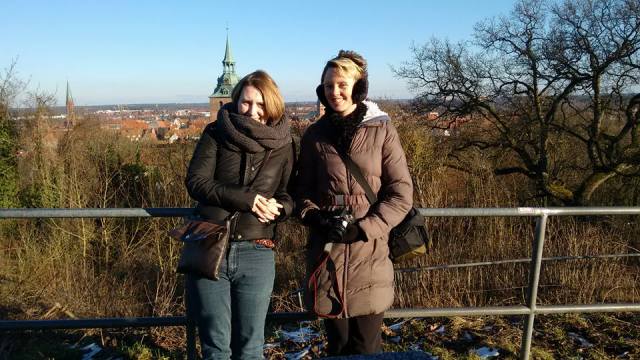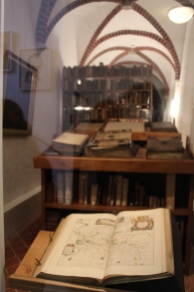Just 20km south of Hamburg’s bustling downtown and industrial river ports lies the little town of Lüneburg, a city frozen in time.

It’s easy to forget the city of Hamburg is much older than the second world war, because outside of a few restored churches, not many buildings from the pre-war era remain. Lüneburg, on the other hand, escaped the brunt of the bombs in both wars, and periods of affluence followed by poverty in the city’s history lead to beautiful houses being constructed, then preserved, as there was no money to tear them down and build anew. The result is like a step back into the middle ages.

Lüneburg perfectly captures that old feeling that American tourists visiting Europe so love – and has some truly excellent Christmas markets in December, too.
My friend Kate, world’s best tour guide
An American friend I’d met in Denmark happened to be passing through Hamburg on her way from Aarhus to Lüneburg one day, so we met up for a quick lunch near the main train station to catch up. I found out she had previously studied abroad in Lüneburg and was on her way to visit old friends and former roommates there. Her eyes sparkled as she passionately told me about her favorite city, sharing all sorts of insider knowledge and local history with me. Germans, having grown up around incredibly old stuff, tend to take it for granted and not think much of it. This girl, however, was an American, and it fascinated her.

I realized, with her knowledge of the city, she would make an excellent tour guide, and so I asked if she might be willing to show me around the city one day during her visit. I got a small group of friends together, and the result was a fantastic narrated city tour by someone with the secret knowledge of someone who’d lived there but the sense of wonder of someone who hadn’t grown up there.
First stop: The City Hall tour
While I’m not one much for guided tours, Kate insisted we take a tour of the Rathaus, or city hall, and I’m glad she did. The Rathaus is one of the oldest and largest buildings in all of Lüneburg, built in 1230 and still used for city administration today. Its facade creates an imposing figure over the town square.

I was disappointed to find out that absolutely no photography was allowed inside of the Rathaus, and that the guided tour was only offered in German. The tour guide turned out to be an elderly man, and even with my excellent knowledge of German I had trouble understanding him. But even if I hadn’t been able to understand a single word, the tour would have been completely worth it.
The Rathaus is actually a collection of several buildings the size of a small city block that used to be separate and were then connected as the city’s administration expanded during times of prosperity. Although only a small part of it is used today, the rest is preserved to maintain the city’s history. Highlights of the tour included seeing replicas from Lüneburg’s former silver treasury, which had been sold centuries ago when the city needed money; seeing the stained glass windows on the facade from the inside light up by the early-afternoon sunlight; hearing the legend of the boar which lead a hunter to the rock salt deposits in Lüneburg which were the source of the city’s wealth for centuries; a beautiful old painting illustrating an exonerated man’s relief at prevailing justice; and scripts on the walls in gold-inlaid old German calligraphy, which I struggled to read. A laminated pamphlet was available for English-speaking guests, which, although not as detailed as the spoken tour, was still helpful for learning about the building’s history.
A little bit of history
Fun fact: Like Hamburg, Lüneburg is a Hansestadt (Hanseatic City), meaning the city was an important place in the routes of northern European traders in the middle ages. I had to look that one up! The history of Lüneburg is virtually without beginning – archaeological evidence suggests Neanderthals and other early humans had lived in the area – but the city rose to prominence in the 1350s for its role in the salt trade. The city had both large, valuable salt deposits and a small harbor on a tributary to the Elbe, so you can imagine its importance in trade. The German Salt Museum commemorates this history. (We didn’t go there, so I can’t recommend it to you).

One effect of salt mining is that it destabilized the ground in parts of the city, causing the ground to sink at an alarming rate of several centimeters per year and several buildings to be damaged and need to be torn down. According to Kate, the decision whether or not to tear down these old buildings is controversial, because while on one hand the city wants to preserve its history (and its tourist attractions), many are unsafe and in danger of collapse, and tearing them down at this point would be easier than renovating them.
Hidden gems at the local library
Our next stop was the library, which seemed like nothing special. It was certainly nothing compared to the great works of modern architecture or cathedral-like structures I’d seen in other European cities. It did hold a pleasant surprise, however: a small room in the back held ancient tomes that were hundreds of years old in a climate-controlled room on display, remnants of history which had survived a major fire back in the day.
We then stopped by the St. Michael’s Church, where Johann Sebastian Bach had sang in the choir from 1700-1702. Unfortunately the church was closed when we got there so we could only see it from the outside.
After that we hiked up the Kalkberg (Chalk Mountain) where we got a beautiful view of the city from above.
Click on the photos to enlarge them
Red roses, red lights
On our way back down, we passed through Lüneburg’s red light district, which turned out to be just one tiny street. At 4 p.m. on a weekday afternoon, only a couple of the display windows were occupied by bored-looking women in their underwear, and one of them was reading a book.

We stopped for tea at a little organic cafe to warm up and rest our legs for a while. Going through the city center, we got a pleasant surprise: A film crew was out! They were filming for Rote Rosen (Red Roses), a soap opera that airs on German public television and takes place in Lüneburg. The camera crew was just getting set up as we passed by.
Our last stop of the day was the harbor, which appeared tiny, quaint and rustic compared to Hamburg’s sprawling industrial port on the river. It’s hard to believe Lüneburg once dwarfed Hamburg!
Because we were only there for a few hours one afternoon, there are a few things we missed out on. We didn’t get a chance to see the Bardowicker Mauer, or old city wall, and we didn’t go to the Tiergarten, or animal park. I was particularly keen to visit the park, because although nearly everyone in the city knew it as a public park, Kate had told us the little-known fact that the large fenced fenced-off grassy area was actually a mass grave where victims of the nearby Nazi concentration camp Neuengamme were sent to be buried. I was pretty shocked to learn this – the thousands of WWII memorials around Germany make the horrors of the Holocaust impossible to forget, yet the extent of the crimes against humanity were so great that apparently some of them have been more or less successfully covered up.


Lüneburg perfectly embodies that small-town, old-timey charm that springs to mind when Americans envision Europe. Just a 30-minute train ride south of Hamburg, it’s definitely worth a day trip. Its crumbling medieval houses are authentic, its architectural style is distinctive, and its cobbled streets are cozy. It’s the perfect escape from the glass and steel, neon lights, and high-rise buildings that characterize much of Hamburg’s downtown, and unlike better-known cities, you get that authentic small-town vibe without feeling like you’re stuck in a tourist trap. Often overlooked in the shadow of Hamburg, Lüneburg is small enough that the guidebooks don’t really mention it, yet big enough that you can easily spend a day walking around it and not get bored.



















Pingback: ≫ Aprenda historia en el Museo Alemán de la Sal en Lüneburg
Pingback: Weird & Offbeat: The German Salt Museum in Lüneburg –cherylhoward.com